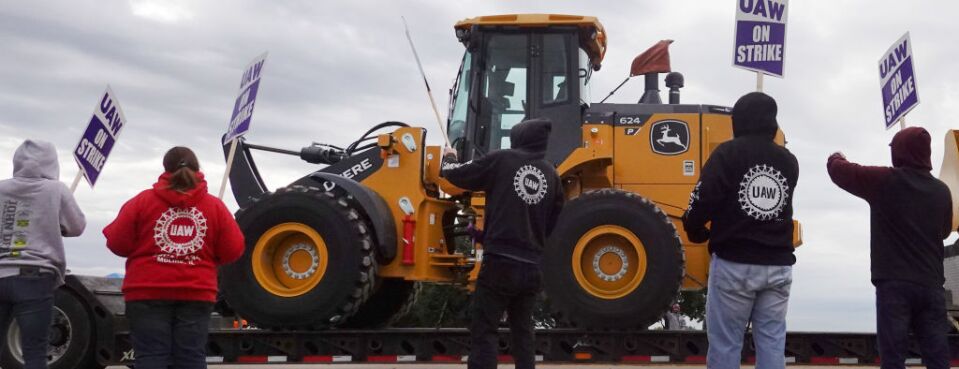
There’s no doubt that millions of workers have hesitated to return to their old workplaces in a world where the Covid-19 pandemic still lingers. Wages are going up amidst this “labor shortage” and some unions have indeed chosen this season to bargain for better contracts and hit the picket line should employers prove recalcitrant.
Things are a lot different today than a decade ago when a paltry government stimulus, mass unemployment, and a slow recovery made workers fear that any strike would just serve as an excuse for the employer to close the factory or import scabs.
The current strike wave is not, in fact, very large by historical standards. In 1979 there were 235 work stoppages involving more than 1,000 workers. So far this year there have been just 12.
There just aren’t that many people enrolled in a trade union, slightly over 10 percent of the working population today, down by half in the years since Ronald Reagan opened the door to contemporary management’s fierce anti-unionism by breaking a strike of air traffic controllers in 1981.
A Mood Shift
Forty years on, the public mood is much different. Last winter scores of eager young journalists descended upon Bessemer, Alabama to cover the union effort there to organize an Amazon distribution center.
And today there is a palpable expectation that the uptick in strikes and organizing efforts will lead to a revival of the American labor movement. That’s not just because so many “essential workers"—from hospital staff to checkout clerks—have generated so much heartfelt support. It’s also because liberals know that something is missing from the body politic, and that something is a labor movement of sufficient strength to not only raise wages at the work site, but wield the kind of political power that once made Midwestern Republicans willing to raise the minimum wage, vote for civil rights laws, and even increase social spending.
If West Virginia had the union density today that it did at the start of Joe Manchin’s career, the mountain state would be solidly Democratic and its senior senator far more of an enthusiast for the social programs and tax-the-rich proposals he now scorns.
Both liberal pundits and union activists are therefore anxious to conjure up a strike wave out of the new-found militancy on offer. On the picket lines at John Deere, where 10,000 workers are on strike and among the 60,000 studio crew that just averted a strike, a radical, self-confident spirit has been unleashed. And from President Joe Biden on down, a lot of Democrats are finally saying, “We don’t want just free and fair collective bargaining, a balanced table. We want labor to win!”
Employers Raise Wages, Resist Organizing
The problem is that employers are not dumb. They have been raising wages all over the place to retain a workforce—you can get $19 an hour just by walking in the door at Amazon, and even Dollar General is paying more than minimum wage.
But they resist the actual organization of their workers into a functional union. They deploy all the economic power, legal talent, and law-breaking necessary to preserve managerial authoritarianism.
In Buffalo, N.Y., when workers at four Starbucks made public their effort to win a National Labor Relations Board election, regional managers and “trainers,” all earning many times more than the embattled baristas, poured into the stores, intimidating by their very presence.
Non-union workers, no matter how aggrieved, do not go on strike. They can quit their job, even walk out together for a shift or two, but in the absence of some independent organization, and that is almost always a trade union, their protest soon dissolves.
Virtually every strike in today’s headlines, from that of the agricultural implement workers in Iowa, to the coal miners in Alabama, and the studio crews in Hollywood, are members of unions formed 80 years ago in the Great Depression. It does not matter if the union was once radical or conservative, organization is essential to any sustained and potent worker protest.
And once the strike is over, that same organization does not fade away. It stays right there in management’s face, policing the contract, mobilizing the workers, lobbying politicians, and preparing for the next contract fight.
Strikes Require Workers Who Are Organized
So, we aren’t having a strike wave. We sorely need one, but that first requires the unionization of millions of new workers. Congress needs to pass the Protecting the Right to Organize Act.
But even more important, the reawakening of an insurgent spirit requires much worker and citizen action. So, let’s therefore remember the words of Joe Hill, the radical troubadour, just before he was executed by a firing squad in 1915: “Don’t mourn – Organize!”
This column does not necessarily reflect the opinion of The Bureau of National Affairs, Inc. or its owner.
Write for Us: Author Guidelines
Author Information
Nelson Lichtenstein Distinguished Professor in the Department of History at UCSB, where he directs the Center for the Study of Work, Labor, and Democracy.
"strike" - Google News
October 28, 2021 at 03:01PM
https://ift.tt/31435bv
Are We Really Having a Strike Wave? - Bloomberg Law
"strike" - Google News
https://ift.tt/2WheuPk
https://ift.tt/2VWImBB
Bagikan Berita Ini














0 Response to "Are We Really Having a Strike Wave? - Bloomberg Law"
Post a Comment